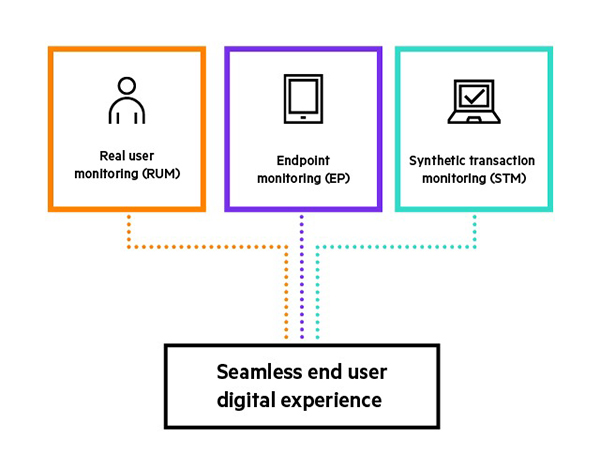
What is Digital Experience Monitoring?
Digital experience monitoring (DEM) is an IT management technology that provides detailed insight into the end-users and devices digital experience on a network as users/devices access different internal and external applications, 24×7.

Digital experience monitoring explained
Digital experience monitoring (DEM) solutions work like a remote technician to solve the most pressing IT challenges related to end-user digital experience monitoring. A DEM solution is usually installed near or on end-user devices and continuously monitors network and application performance at the edge.
Gartner™ outlines the three significant capabilities of DEM, as follows:
- Real user monitoring (RUM), which measures user experience from the perspective of the application (e.g., at a web application level)
- Endpoint monitoring (EP) technologies that provide visibility into end-user devices
- Synthetic transaction monitoring (STM) technologies that have been around for decades and help organizations proactively test services, such as SaaS1

Why is DEM important?
IT teams often face situations where network performance appears fine, yet have end users raising concerns about slow connectivity speed. Usually, these complaints are anecdotal, like slow Wi-Fi, dropped calls, Microsoft Teams not loading, etc. Without a DEM solution, IT can struggle to understand the end-user side of network performance and often must travel onsite to try to replicate issues.
A DEM solution provides IT with a holistic dashboard that showcases the end user experience on the network, identifies hop-to-hop latency, and pinpoints the root cause and timing of performance issues.
What are the benefits of DEM?
Digital experience monitoring can help IT:
- Optimize the end user digital experience: A user-centric view of network performance helps IT proactively improve network and application performance and ensures business-defined XLAs and network performance SLAs are met, improving end user productivity and building credibility.
- Track network and application performance: Continuous testing of networks and applications for availability, responsiveness, and performance helps IT stay ahead of outages and reduces downtime by isolating the root cause of a network or application issue. DEM solutions also enable IT to understand the hop-by-hop journey of users on various applications and take corrective measures to optimize the experience.
- Rapidly troubleshoot help desk tickets: Identifying the root cause of network issues helps reduce MTTI and MTTR by isolating whether an issue is related to an end user device, the network, the application, or a service provider. Analyzing these issues remotely on a cloud-hosted dashboard reduces network monitoring costs by cutting down on the need for instant truck rolls.
- Analyze device performance: Insight into device health helps IT address security gaps, rapidly respond to help desk complaints related to device performance, and factor in device fitness in overall network and application performance analysis.
- Validate change management: The ability to compare network performance before and after a network change is of significant benefit. Traditionally, IT updated network parameters and then waited for end users to test new configurations and provide feedback—an approach that could result in an approach that could result in negative user experience that could have been avoided. With a DEM solution, IT gets feedback on network changes in real-time, enabling them to take action before end users are impacted.
According to Gartner2, “The reliance on diverse suites of technologies to support digital business has placed significant emphasis on understanding application performance, user experience requirements and security postures across the entire network fabric. The analyst firm further stated, “Disruptive network technologies that focus on application performance and end-user experience drive the majority of innovation in the overall enterprise networking market.”
How does DEM work?
A DEM solution often consists of sensors or agents installed near or on end user devices that continuously monitor network, application, and device performance, by running synthetic tests or by tracing user’s digital path. The analyzed data is presented to a cloud-hosted dashboard that alerts IT teams when it encounters issues related to the network, applications, or devices.
DEM solutions that are offered as part of a SASE framework may leverage existing agents, connectors, or in-line traffic brokering via the cloud to natively provide all necessary metrics.
What are the critical functions of a DEM solution?
Some of the critical functions of a DEM solution include:
- Active and passive testing of network applications (SaaS and web applications) via agents or sensors–using TCP or ICMP
- Analyzing edge device health by reading device details like serial number, IP address, IP Config, gateway, DHCP, primary/secondary DNS, battery percentage, temperature, location, CPU usage, disk and memory usage, top destinations, etc.
- Visualizing network path and Wi-Fi environment details
- Providing on-demand network and application performance reports
- Enabling IT to export network and application performance data to a big data platform for further analysis
- Helping IT remotely troubleshoot network and application issues
How to select a DEM solution?
There are a variety of DEM solutions available to choose from depending on business use case, budget, and manageability.
Here are some important considerations when choosing a DEM solution:
| Parameter | Criteria |
|---|---|
| Strategy | Should be inline with broader brand differentiation and network security strategy |
| Deployment | Easy to deploy and install a hardware sensor or agent with little |
| Scalability | Adding new hardware sensor, agent, or subscription should be quick and seamless |
| Security | Doesn’t interfere with network security or leave the network susceptible to attack Regular updates and patches to DEM solution integrate easily without creatingsecurity challenges |
| Trust and reviews | Provides quantifiable results within hours, if not minutes, of installation Has positive feedback from users and analysts |
| Business use cases | Meets business/IT requirements, like SLA and XLA monitoring, change management, cost reduction, high ticket prioritization, etc. |
| Integration | Easy to integrate with pre-existing network infrastructure |
Why HPE Aruba Networking for DEM?
HPE Aruba Networking offers two complementary products that analyze, monitor, and troubleshoot network and application performance from an edge perspective:
- HPE Aruba Networking User Experience Insight is a dedicated AI-powered DEM solution that runs synthetic tests using hardware sensors and agents to provide precise visibility into network health and application performance, 24×7.
- HPE Aruba Networking Experience is a cloud-delivered DEM solution that ensures user productivity by measuring hop-by-hop metrics and monitoring app, device, and network performance via agent or agent-less methods. The product is delivered as a part of the broader HPE Aruba Networking Security Service Edge (SSE) solution.
These two solutions use different approaches to monitor end-user digital experience on the network. When used together, they provide an end-to-end perspective of digital experience, covering all the significant use cases listed by Gartner:
Real user monitoring (RUM): By replicating the end user journey on web applications, HPE Aruba Networking UXI sensors and agents provide a detailed triage, with screenshot, whenever an issue is encountered. Click-by-click web tests can be recorded using Selenium and uploaded to UXI from the dashboard.
HPE Aruba Networking Experience DEM software agent-based or agentless solutions track users’ journeys on web applications and provide hop-by-hop visibility into application performance for every session.
Endpoint monitoring (EP): HPE Aruba Networking UXI Agent is deployed on end-devices and provides device specific information like: Persistent Device Identifier (PID), serial number, IP address, primary/secondary DNS, battery percentage, temperature, location, etc.
HPE Aruba Networking Experience is part of an overarching Security Service Edge (SSE) platform which supports agentless access via a browser or agent-based access via a client installed on edge devices (Windows™, Apple OS, iOS, and Android™) to monitor and analyze device health on a cloud dashboard.
Synthetic transaction monitoring (STM): HPE Aruba Networking UXI sensors and agents run synthetic tests to monitor SaaS and web applications and tests their reachability, responsiveness, and performance from an edge perspective.
As part of a greater cloud offering, HPE Aruba Networking Experience sits in-line on edge devices and monitors each user journey, reports each hop, and alerts IT and security if it finds inconsistencies with the predefined protocol or detects irregular latency.
Quantify end-user experience with a DEM solution
A DEM solution helps IT answer critical questions about network, application, and device performance that impact end-user experience.
A DEM solution provides answers to the following critical questions:
- How does a user’s journey look on different applications?
- Can end users easily access all their critical apps on the network?
- What is the root cause of a network connectivity issue?
- Is a network outage local, or is it global?
- Are network performance SLAs (Service Level Agreements) being met?
- Are business-defined XLAs (Experience Level Agreements) being met?
- How can network performance data be used for better network planning?
- How can I validate network changes before they impact end user experience?
- How are devices on the network performing?
- How can I troubleshoot network issues before they impact end users?
Related digital experience monitoring resources
Explore how HPE Aruba Networking addresses digital experience monitoring.
HPE Aruba Networking User Experience Insight (UXI)
No more slow network help desk tickets. See what your end users are experiencing, so you can troubleshoot in real time. AIOps-powered DEM monitors your network 24×7.
What happens when you don’t monitor end user experience?
The cost of not monitoring end users experience on your network is very high, learn how HPE Aruba Networking User Experience Insight is helping businesses across verticals to reduce this cost and making their network future ready.
User experience testing
Ensure continuous testing and performance monitoring of apps and services across your entire network to evaluate service levels from a perspective that matters most—your end users.
HPE Aruba Networking UXI Sensor
Offering a simple zero touch deployment plan, these purpose-built, Linux-based client devices can be provisioned via PoE or wall outlet power with no cable pulls required. Providing continuous testing of the network and in-use applications, you can easily install the sensors in high density locations to mimic users on your network.

